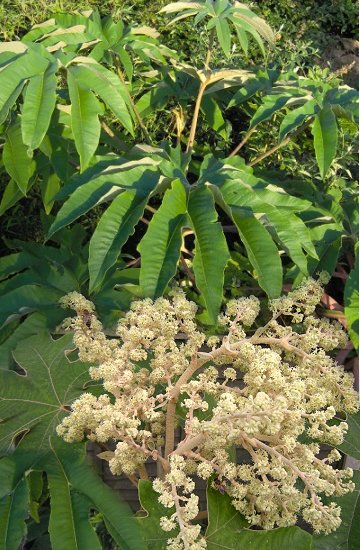
|
|
Rice-paper Plant
(etrapanax papyrifer). Leaves and flowers
|
Rice-paper Plant -Tetrapanax papyrifer
Tetrapanax papyrifer (tong cao, or Rice-paper Plant) is an evergreen shrub in the family Araliaceae, the sole species in the genus Tetrapanax. The specific epithet is frequently misspelled as "papyriferum", "papyriferus", or "papyrifera". It is endemic to Taiwan, but widely cultivated in East Asia and sometimes in other tropical regions as well. The species was once included in the genus Fatsia as Fatsia papyrifera.
A second species, Tetrapanax tibetanus, is now regarded as a synonym of Merrilliopanax
alpinus.
Tetrapanax papyriferum is a shrub, up to 6 meters in height. Stems are woody but soft, flake-like when young but gradually full when older, and with white pith in the middle. The young branches are densely covered with stellate hairs, or slightly with grayish yellow deciduous fluff.
It has usually unbranched stems 2 cm diameter bearing a rosette of large leaves at the top (superficially similar to a palm crown). Large leaves, usually clustering in the upper stem, are palmately divided, up to 1 meter long, and with heart-shaped base, 5-7 lobed blade, stout, 30 to 50cm petiole, and 2 stipules.
The central lobes larger and Y-forked near the end. It spreads extensively by sprouts from the root system underground.
Flowers are small and petiolate. The inflorescence is a large panicle of hemispherical to globular umbels near the end of the stem.
Most globular umbels arrange into a large cone. The flowers have 4 or 5 small white petals.
Drupelike berry is nearly spherical and flat. Exocarp is fleshy, hard and brittle. Bloom time is in August and fruiting time is in September
Tetrapanax papyrifer is used in traditional Chinese medicine and as an ornamental. The pith from the stem is used to make a substance commonly known as rice paper, but more properly termed pith paper.
Rice paper is an umbrella term that has been used to collectively refer to several paper-like materials from East-Asia made from various plants,
but originally known as rice paper, due to the mistaken notion that it is made from rice. In different context rice paper may refer
to thin peeled dried pith of Tetrapanax papyrifer: A sheet-like "paper" material was used extensively in late 19th century Guangdong China as a common support medium for gouache paintings sold to Western clients of the era. The term was first defined in the Chinese-English Dictionary of Robert Morrison who referred to the use of the Chinese medicinal plant as material for painting, as well as for making artificial flowers and shoe soles.
In order to produce the paper from Tetrapanax papyrifer, the boughs are boiled and freed from bark. The cylindrical core of pith is rolled on a hard flat surface against a knife, by which it is cut into thin sheets of a fine ivory-like texture.
Dyed in various colours, this rice paper is extensively used for the preparation of artificial flowers, while the white sheets are employed for watercolor drawings. Due to its texture, this paper is not suited for writing.
Rice paper plant, also known as Tetrapanax papyriferum or Tong Cao in mandarin, is a traditionally used medicinal plant. And the main medicinal part is its long, round pith, which looks like a wick and touches like sponge or foam. Rice paper plant pith, a medium-grade drug initially included and rated by the “Shen Nong’s Herbal Classic”, has a long history of use in folk medicine as a galactagogue.
Medicinally is mostly cultivated in Guizhou, Yunnan, Sichuan, Taiwan, and Guangxi. The medicinal stems are reaped in autumn. And then cut them into sections, take the fresh pith out when they are still fresh, straighten, dry in the sun, and slice. Medicinally it is used raw. By the way, rice paper plant flowers, buds, root, and pollen are used for medicinal purposes too.
Modern pharmacology has confirmed that it is diuretic and can significantly increase the urinary excretion of potassium and promote milk secretion and so on. What’s more its polysaccharide is with a certain antioxidant and immunity-regulating effects.
Source:
http://en.wikipedia.org/wiki/Tetrapanax
http://en.wikipedia.org/wiki/Rice_paper
http://www.chineseherbshealing.com/rice-paper-plant/
